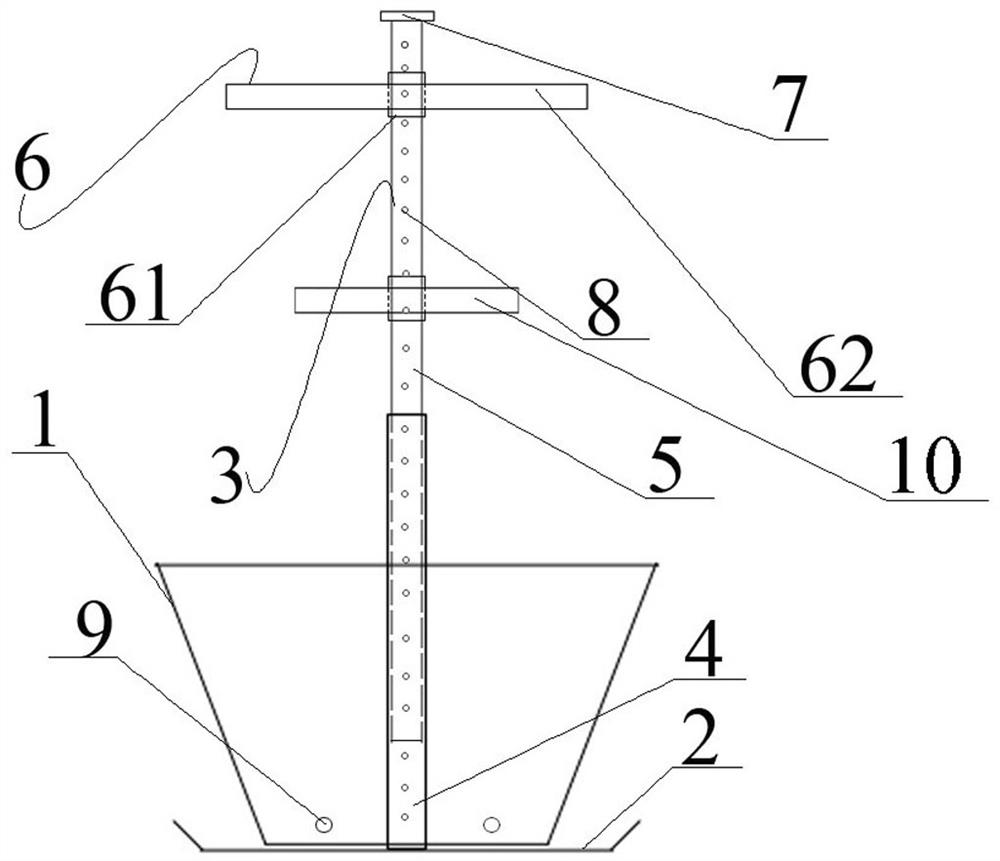Cultivation method for household pitaya bonsai
A cultivation method and technology of pitaya are applied in the field of potted cultivation of pitaya for home use, and can solve problems such as difficulty in achieving expected cultivation purpose, disordered growth of pitaya, and difficulty in fruiting of pitaya, and achieve the advantages of being beneficial to indoor production, convenient in proportioning, low cost effect
- Summary
- Abstract
- Description
- Claims
- Application Information
AI Technical Summary
Problems solved by technology
Method used
Image
Examples
Embodiment 1
[0033] S1, planting pot preparation: the planting pot includes the planting pot body 1, the belt edge tray 2 and the supporting branch part 3, the planting pot body 1 is a circle with a diameter of 30-40 cm, a bottom diameter of 25-30 cm, and a depth of 25-35 cm The container, the planting pot is placed on the belt edge tray 2, and the outer wall near the belt edge tray 2 is provided with a water outlet 9; the belt edge tray 2 is provided with a support tube 4, and the bottom surface of the plant pot body 1 is provided with a support tube 4 to pass through perforation, the support branch part 3 includes an externally threaded pipe 5 threadedly connected with the support pipe 4 and an upper support branch ring 6 and a lower support branch ring 10 arranged on the external thread pipe 5, wherein the lower support branch ring 10 has a diameter of The diameter of the upper support ring 6 is 40 cm, the distance between the lower support ring 10 and the top surface of the planting soi...
Embodiment 2
[0045] S1 planting pot preparation: use ordinary planting pots with holes in the bottom, with a diameter of 30-40 cm, a bottom diameter of 25-30 cm, and a depth of 25-35 cm;
[0046] S2 Planting soil preparation: Lay 1-3cm thick organic fertilizer on the bottom of the plant pot as the base fertilizer, and mix the garden soil, coconut bran, and nutrient soil in a ratio of 3:1:1 to form the planting soil;
[0047] S3 cutting seedling selection: with embodiment one;
[0048] S4 Planting soil potting: Load the mixed planting soil to 1 / 2 of the height of the planting pot body 1, cut off all the thorn seats of the cutting seedlings except for a few thorn seats on the top, insert the cutting seedlings into the planting pot, and cultivate the soil. To 3 cm from the edge of the planting pot, lightly press the soil around the plant with your hands, water the fixed roots thoroughly, and complete the planting. After planting, place it in a sunny and ventilated place;
[0049] The managem...
Embodiment 3
[0051] S1 planting pot preparation: with embodiment one;
[0052] S2 Planting soil preparation: Lay 1-3cm thick organic fertilizer on the bottom of the plant pot as the base fertilizer, and mix the garden soil, coconut bran, and nutrient soil in a ratio of 3:1:1 to form the planting soil;
[0053] Selection of S3 cutting seedlings: the cutting seedlings are selected as one of Jindu No. 1, Soft Branch Red, and Thornless Red Dragon. The variety used in this embodiment is Jindu No. 1. Cutting seedlings with natural growth of no more than 100cm and a growth length of no more than 80cm that can bloom and bear fruit naturally, cut the thick and fruiting old branches with a length of 50-60cm, and directly cut them;
[0054] S4 planting soil potting: load the mixed planting soil to the height 1 / 2 of the planting pot body 1, select four cutting seedlings to be located directly below the four supporting branch rings 6 spaces, and the cutting depth is 10 ~15cm, the height outside the pl...
PUM
| Property | Measurement | Unit |
|---|---|---|
| Caliber | aaaaa | aaaaa |
| Bottom diameter | aaaaa | aaaaa |
| Depth | aaaaa | aaaaa |
Abstract
Description
Claims
Application Information
 Login to View More
Login to View More - R&D
- Intellectual Property
- Life Sciences
- Materials
- Tech Scout
- Unparalleled Data Quality
- Higher Quality Content
- 60% Fewer Hallucinations
Browse by: Latest US Patents, China's latest patents, Technical Efficacy Thesaurus, Application Domain, Technology Topic, Popular Technical Reports.
© 2025 PatSnap. All rights reserved.Legal|Privacy policy|Modern Slavery Act Transparency Statement|Sitemap|About US| Contact US: help@patsnap.com


